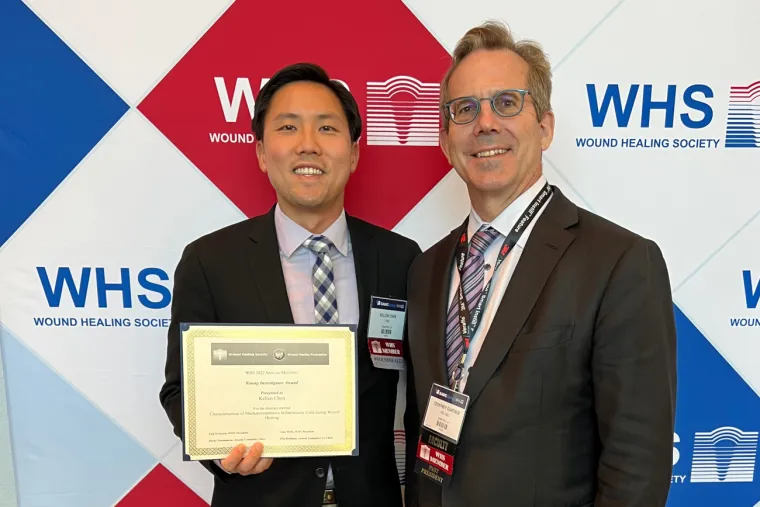Turning Down the Volume on Scar Formation to Promote Healthy Wound Healing

University of Arizona College of Medicine – Tucson scientists added a drug to standard wound treatments to promote the regeneration of healthy tissue and reduce excessive scarring.
A University of Arizona College of Medicine – Tucson team uncovered a potential treatment for survivors of blast wounds, burns and other devastating injuries that can lead to disfiguring or debilitating scars. The study, recently published in Science Translational Medicine, found in animal models that a drug called a FAK inhibitor appeared to reduce scarring and promote the regeneration of healthy skin in skin grafts.

As a wound closes, skin cells create collagen, which forms the building blocks of a scar. Scar tissue is stiff and inflexible, and excessive collagen production can result in scarring that impedes movement or facial expression, as when a scar covers the elbow or the face.
"Evolutionarily, after a large injury, our bodies just want to close the wound as soon as possible to prevent infection and help control bleeding, even if it creates scar tissue," said lead author Kellen Chen, PhD, assistant research professor in the Department of Surgery. "With modern medicine, we're trying to prevent that dysfunctional and unappealing scar tissue, and instead promote regenerative healing to have more normal skin."
Innovations in wound care are needed, according to clinicians who see the effects of serious wounds on a daily basis.
 "In severe burns, lifesaving skin grafts lead to nerve entrapment and range-of-motion-limiting contractures, which can only be addressed with lifelong surgical procedures," said Lourdes Castañón, MD, FACS, clinical assistant professor of surgery at the College of Medicine РTucson and director of the Banner РUniversity Medicine Burn Program, who was not involved in the study. "From a clinical care and quality of life perspective, this research is encouraging for its potential to reduce scarring and promote healthy wound healing and skin regeneration for burn victims."
"In severe burns, lifesaving skin grafts lead to nerve entrapment and range-of-motion-limiting contractures, which can only be addressed with lifelong surgical procedures," said Lourdes Castañón, MD, FACS, clinical assistant professor of surgery at the College of Medicine РTucson and director of the Banner РUniversity Medicine Burn Program, who was not involved in the study. "From a clinical care and quality of life perspective, this research is encouraging for its potential to reduce scarring and promote healthy wound healing and skin regeneration for burn victims."
Turning down the volume on collagen
At the site of an injury, a protein called focal adhesion kinase, or FAK, sets off the production of a collagen-rich "matrix" on which new scar tissue develops. In partnership with Geoffrey Gurtner, MD, FACS, senior author and department chair of surgery, Dr. Chen is investigating whether a FAK inhibitor could reduce scarring when added to standard wound treatment, building on research conducted when they were at Stanford University.
Normally, severe wounds are covered with surgically transplanted grafts of a patient's healthy skin, along with a dressing called a hydrogel that provides protection to the wound and decreases pain. The Gurtner Lab found that skin grafts treated with a hydrogel infused with the FAK inhibitor looked more like healthy skin, while untreated skin grafts produced more collagen and other "stiffer" proteins.
"Treated skin grafts are making less collagen, closer to levels found in normal, unwounded skin," Dr. Chen said.
By turning down the volume on collagen production, the team hopes that wounds treated with a FAK inhibitor might be able to heal without producing excessive scar tissue that often hurts more than it helps.
The architecture of a scar
Dr. Chen said it's not just the high levels of collagen that cause a scar to be stiff and inflexible — it's also caused by how collagen is arranged at the microscopic level. In healthy skin, collagen arranges itself like a net. But when a wound resists staying closed, tensive forces cause the collagens in the scar tissue to align like a bundle of ropes, producing scar tissue that is strong but lacks elasticity.
"We want the healing skin to look like that net, because it has that springiness while maintaining its original strength, without being stiff," Dr. Chen said.
The Gurtner Lab found that the collagen present in skin grafts treated with the FAK inhibitor was configured more like a net than a bundle of ropes. They hope that, by treating wounds with a FAK inhibitor, scars will be smaller and more flexible, giving healed skin grafts a fuller range of movement, and appear more like unwounded skin.
Preparing for human trials
The next step is to design a clinical trial to investigate how FAK inhibitors might be incorporated into wound dressings to support the healing process in human skin grafts. There is already clinical safety data on FAK inhibitors, which have been investigated in clinical trials as cancer treatments taken orally. The Gurtner Lab, however, is not giving the drug orally but instead is using a hydrogel to deliver it right on top of the wound.

"Hydrogels are commonly used in burn care, so this technology can be rapidly incorporated into the current standards of care," Dr. Gurtner said. "A topical application will be safer and easier to incorporate in the clinic because it is very similar to what we already do."
Applying it directly to the skin allows them to use much lower doses of the FAK inhibitor than those previously investigated.
"We're using less than 1% of the maximum tolerated dose tested in cancer clinical trials," Dr. Chen said.
Dr. Chen began his work as a graduate student, peering at collagens under the microscope to understand how physical stimuli caused them to organize into nets or bundles of ropes. He says following his investigations all the way to the precipice of a clinical trial has been enormously gratifying, especially as a longtime resident of the Western U.S.
"As wildfires continue to rage in Arizona and the West, traumatic burn injuries pose a risk to the population, and typically heal with dysfunctional scar tissue," he said. "I could have gone into any scientific field, but I got into biomedical engineering because I wanted to help patients. It's been really rewarding to see our work grow from experiments in the lab to exploring how we can use this to improve people's lives."
This research was supported in part by the U.S. Armed Forces Institute of Regenerative Medicine (W81XWH-13-2-0054), the National Institute of Dental and Craniofacial Research (U24DE026914), the Plastic Surgery Foundation (837107) and the National Institutes of Health (R01GM116892).
Contacts
Anna C. Christensen

